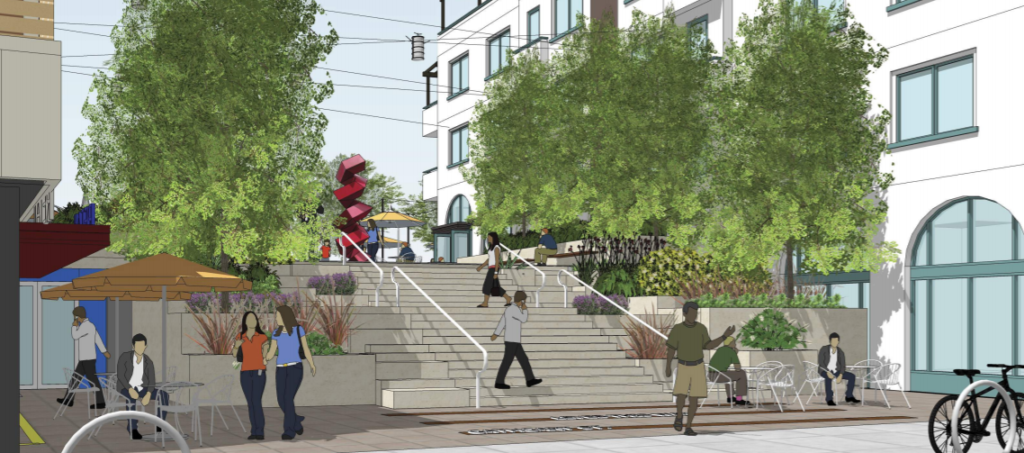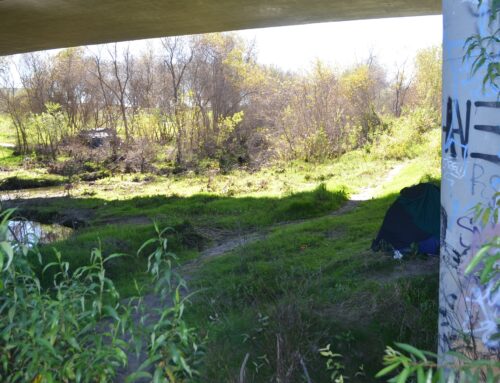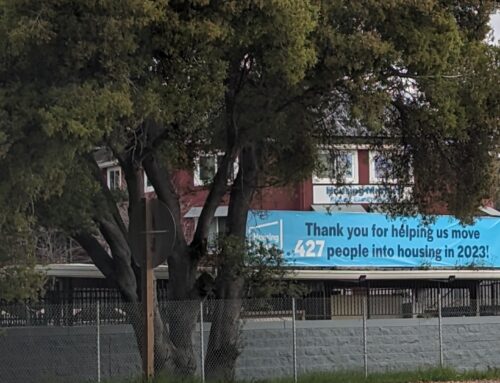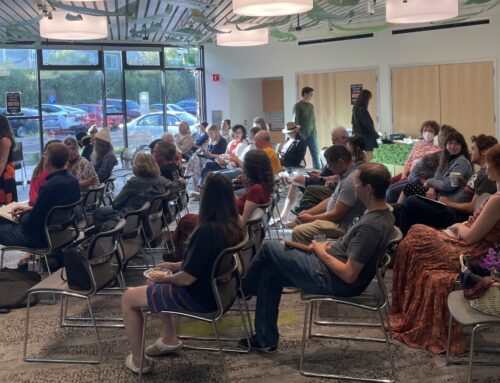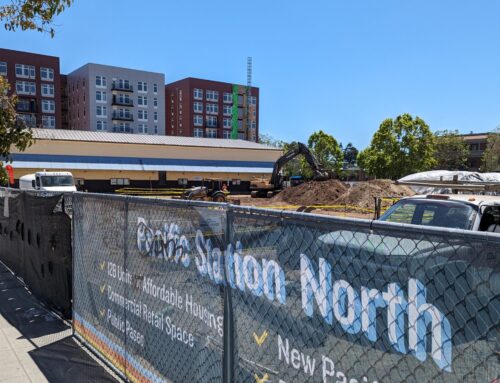Santa Cruz Local offers its news stories free as a public service.
We depend on people like you — we call them our Santa Cruz Local members — to chip in $9 a month or $99 a year so vital information can be available to all. Can we count on your support?
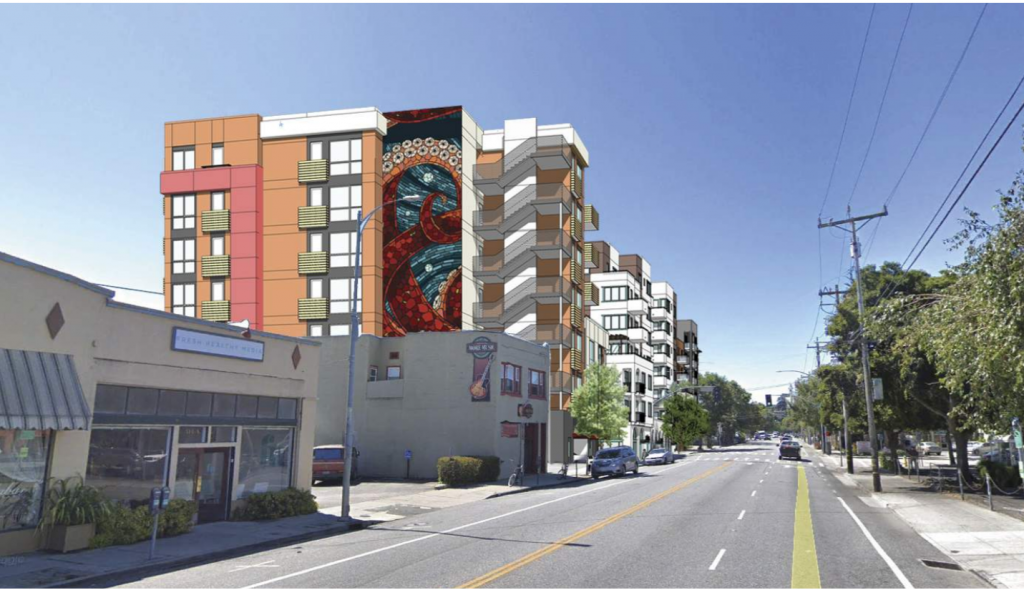
SANTA CRUZ >> A proposal for a seven-story housing project between Front Street and the San Lorenzo River has driven a wedge between the Santa Cruz city planning department and California Coastal Commission staff on the building’s height. The outcome — along with a similar proposal at 190 West Cliff Drive — could set a precedent for how the Coastal Commission balances a state law to spur more affordable housing and Coastal Act standards for development.
The Riverfront project on Front Street calls for 175 condominium units, 42 more units than allowed by zoning. The local developer, Owen Lawlor, applied for a “density bonus” that essentially allows the plan to have more units, increased height and a larger top-floor area than city standards allow. In return, the developer would build more affordable housing for people with qualifying incomes under state law.
The Riverfront project’s height of about 78 feet exceeds zoning standards by 8 feet. To qualify for the bonus, the developer plans to offer 15 condominiums at affordable rents to people with very low incomes. Lawlor said the units would start as rentals but may be sold later, based on how the project is financed.
Limits for rents and income for affordable housing are based on area median income and household size. Altogether, the project would have 20 affordable units.
Very-low income units are rarely built in Santa Cruz. As of July, Santa Cruz staff had permitted 12 very-low income units in about five years. State requirements call for Santa Cruz to permit an additional 168 very-low income units by the end of 2023.
(Riverfront project renderings: Humphreys & Partners Architects, L.P.)
The plans
The project is slated for five parcels on the east side of Front Street, at the end of Cathcart Street downtown.
It calls for:
- The demolition of three commercial buildings, two of which are considered historic by the state and city. Tenants include The 418 Project dance studio, Mutari Chocolate and University Copy Services.
- Three proposed buildings with a total 175 condominiums above commercial space that opens to Front Street and the San Lorenzo Riverwalk.
- Two wide walkways that connect Front Street with the Riverwalk.
- Private open areas on the roof, a private gym, game room and lounge.
Coastal Commission’s view
Since the project is along the lower San Lorenzo River which feeds into the ocean, the project is in the coastal appeal zone. That means that members of the public or Coastal Commission staff can appeal a city council approval to the Coastal Commission. Then the Coastal Commission has the final vote.
State law allows developers to receive a density bonus as long as it doesn’t reduce the impact of the Coastal Act. That’s another state law meant to guard natural resources and boost public access to the coast.
Ryan Moroney, the California Coastal Commission Central Coast district supervisor, said in an interview that the project doesn’t have enough affordable units to warrant impacts to coastal resources — namely the view, community character and aesthetics.
“What’s the benefit of basically bending the Coastal Act standards when you’re not really getting much more affordability?” Moroney asked.
Moroney said when the Coastal Commission approved zoning changes in 2018 to allow taller buildings downtown, that set the height and density that the Coastal Commission could accept.
“Anything beyond that starts to impact coastal resources,” Moroney said. Moroney said the mass and scale of a building of that size will impact views, community character and aesthetics.
Moroney wrote a letter to the city council last month that urged the council to push the developer to include more affordable units or conform to zoning. The letter caused the city council to delay a public hearing on the project.
The city council was scheduled to consider the project Tuesday, but the hearing was delayed again until Jan. 12 to allow the developer to meet with Coastal Commission staff, according to a city staff report.
City and Coastal Commission staff have met at least twice in recent weeks to try to resolve the differences.
If the two sides can’t find agreement, then a possible scenario is that the Coastal Commission staff would appeal a city council approval. Then the Coastal Commission would ultimately decide.
In an interview Wednesday, Moroney conceded that the letter incorrectly stated how many affordable units the city law requires. But the letter’s main point still stands, he said.
“Our sense was that there’s really not a whole lot more affordability happening than otherwise would have happened, to be frank. And that’s not the standard of review, that’s not the measure. But that was just an observation. And that’s something our commission really cares about in terms of affordable opportunity [and] in more recent times been really pushing for, and so we thought it was appropriate to at least speak to that issue in the letter,” Moroney said.
City staff’s view
City staff have said that the building’s height will not further impact coastal resources such as the view of the San Lorenzo River.
“If you read their [the Coastal Commission’s] letter, that’s sort of the take,” said Santa Cruz Assistant Director of Planning and Community Development Eric Marlatt in a Nov. 23 interview. “They’re saying, ‘Hey, you know, we just amended your code two years ago, and that’s what we determined to be the height that would be acceptable that wouldn’t impact coastal resources.’ I think we beg to differ on that. I think there needs to be a contextual consideration of what’s going on there.”
For example, the levee already blocks river views from the street, he said. A map in the city’s Local Coastal Program, a development plan approved by the Coastal Commission, lists critical viewsheds in the city. None are in the project, Marlatt said.
Also, several other buildings nearby are taller than the project’s proposed 78 feet, Marlatt said. Marlatt said the Flatiron building is 83 feet and the Palomar is 86 feet. The approved Pacific Front project on Pacific Avenue, Front and Laurel streets will be 85 feet tall.
“When you’re looking at coastal resources, you need to look at the entire picture,” Marlatt said. “So well, yes, it is higher than what’s allowed in the underlying zoning. Look at the project. Look at its location. It’s right across the street from literally the main transportation hub for the entire county. So you’re going to be reducing greenhouse gas emissions because people can walk from their home to public transit. And what does greenhouse gas emissions do? It contributes to sea level rise. That impacts the coast. So what’s more important?”
A precedent
In October 2019, the city council approved 190 W. Cliff, an 89-unit condominium project across from the Dream Inn. The project would be 47 feet tall. It also calls for a density bonus, which allows the project to be taller than zoning allows. To qualify, the developer Cliff Bay Partners plans to offer eight of its 10 affordable units to people with very low incomes.
(190 W. Cliff renderings: Ensemble Investments / Cuningham Group)
The project is in limbo after a series of appeals to the Coastal Commission by four city residents and a neighborhood group called Save Santa Cruz Westside. Reasons for appeal ranged from the unaccounted-for height of likely structures on the project’s fifth-floor roof deck to the removal of heritage trees.
The 190 West Cliff project and the Riverfront proposal are the first instances in the Central Coast District in which the Coastal Commission staff has weighed whether it’s appropriate for development to deviate from local standards, Moroney said.
“We’re looking at whether the deviation of those standards impacts coastal resources. And as I said before, I think, you know, we don’t have a lot of precedent for doing that,” Moroney said.
“And I think we’re leaning toward the position that if it exceeds the standards that were sort of set to protect coastal resources, then the presumption is they’re impacting coastal resources. How much is like, more of a judgmental question, right? That’s something that we’re exploring in both of these cases, and we want to make sure we have a good record and clear information to present to our commission if it ends up going before them on appeal.”
The 190 W. Cliff project and the Riverfront proposal are also the first time the Coastal Commission staff has weighed the state density bonus law since the passage of state law AB2797 in 2018. That law overruled a court decision that held that the Coastal Act superseded the state density bonus law. Instead, AB2797 requires that the state density bonus law and the Coastal Act “be harmonized so as to achieve the goal of increasing the supply of affordable housing in the coastal zone while also protecting coastal resources and coastal access,” according to the law.
Moroney said he expects Coastal Commission staff to meet with city staff and the 190 W. Cliff developer in the next few weeks to let them know of the staff’s recommendation.
Kara Meyberg Guzman is the CEO and co-founder of Santa Cruz Local. Prior to Santa Cruz Local, she served as the Santa Cruz Sentinel’s managing editor. She has a biology degree from Stanford University and lives in Santa Cruz.


